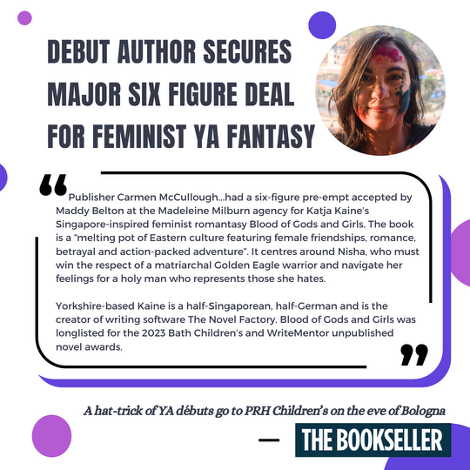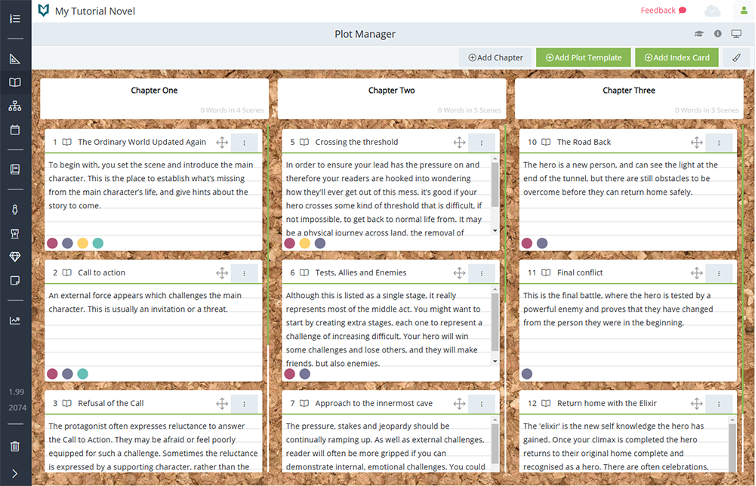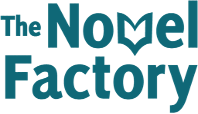
Hi there, I’m Katja Kaine. I’m a writer – my debut novel, a YA feminist fantasy called Blood of Gods and Girls, is due to be published by Penguin Random House in 2026, and I’m also the creator of the Novel Factory, which is purpose-built software for novel writers.

In this article, I’m going to explain a bit about my writing process, and how I’ve harnessed the power of technology to make my writing better structured and more efficient.
When I first started seriously trying to become a writer, around fifteen years ago now, I found that there were two major barriers to my progress.
One was that while I love systems, and for everything to be in its place, I am not the kind of person that keeps things tidy as I go along – I’m more of a wait until I’m drowning in clutter, then do an almighty blitz and end up with everything in colour co-ordinated, perfectly organised categories.
And I found that that ‘style’ applied to my novel writing as well. As I wrote the novel, I would end up with lots of notes and research around characters, plot outlines, subplots, setups and foreshadowing… but all of it scattered all over the place. Some of it would be in Word documents in sporadic, inconsistent folders, some of it would be on post-it notes, and other bits on scraps of paper or in notebooks. And the thought of going through sorting it all out was soul-destroying.
And I thought – there must be a way to create some kind of novel-focused database on a computer, where I can just put things in the right place from the beginning. I imagined it would have sections for: premise, synopses, characters, locations, research and notes, and it would have a word processor for writing the actual manuscript.
In each of the sections, I imagined I’d be able to click a button to add a new character, or whatever it was, and that new character file would include the questionnaire templates I’d collated over the years, which I could fill in and save, without having to keep making copies of the questionnaire manually (and constantly overwriting my master file by accident).
I got a developer to create this concept, and the first version of the Novel Factory was born.
I have found using this sort of organisation system saves me not only hours of admin, but also a ton of mental energy, because I don’t have to think about where I’m going to note something down, or how I’m going to find it again – there’s already a spot ready and waiting for it. It means I can access my notes swiftly, without breaking my creative flow.

The second barrier I came across, was that although I was reading dozens of books on the craft of writing, when it came to actually writing my novel, I couldn’t remember which book had useful bits of information about which aspect of the process. And what’s more – I didn’t know where to start.
Should I start with a plot outline? Or with character profiles? Should I just start writing the novel and see where it goes? When should I be thinking about themes, and foreshadowing?
The first breakthrough I made was when I discovered The Snowflake Method, which is where you start with the simplest concept of your idea and gradually add layers of complexity. This made perfect sense to me, and I studied the steps to go from idea to final manuscript, and then I went back to my favourite books and techniques on writing, and I added steps and shuffled things around until I had created a detailed step-by-step process which made the most sense to me.
I think that the task of writing a novel is so massive, that it’s easy for it to cause decision paralysis – not only at the beginning but throughout the process. Breaking it down into manageable stages has always been the natural solution for me.
So the next thing I did was to integrate the Novel Writing Roadmap I had created for myself into my novel writing software, making sure all the features and functions were there to support me at each stage – from premise, through plotting and character development and various drafts. I even inserted the content of the roadmap itself into the software, so I could refresh my memory of each skill with each new novel. I added checkboxes, so I could check off each step as I completed it (I am the kind of person who will write down an already completed task on a list, just for the satisfaction of crossing it off – don’t judge me)
I find that having everything in one place makes it much easier for me to stay focused, and not get sidetracked looking for a particular book, or pile of post-it notes.
For me, in order to support my creativity and flow – the visual interface of my technology is critical. Just like I can’t work if my desk is covered in clutter, the same goes for overly busy software interfaces – that’s why it’s been critical for me to make sure every Novel Factory interface is easy on the eye. (On a similar note, if software requires me to invest tens of hours in learning how to use it, then it’s already negatively affecting my writing, before I’ve even started – which is why the Novel Factory is carefully designed to be intuitive and not overwhelming).
Having a physical corkboard and cardboard index cards is great. I love that. What I find even better, is having a digital version, which has all the visual cues to make my brain feel like it’s a real corkboard and real index cards – including being able to pick them up and move then around – but it takes up less space, is more easy to correct, and is easier to read than my sloppy handwriting.
Another area where technology has been a crutch to help my struggling brain is when it comes to managing multiple complicated subplots and plot threads. I find it very easy to lose track of these and how they all interact and develop through the novel, and for years I struggled with different methods of keeping them under control.
Then one day I came across the now quite famous picture of JK Rowling’s hand-drawn grid for Harry Potter and the Order of the Phoenix. Down the left are the scene numbers and titles, and along the top are various plot elements.
So, I loved this concept, and it made perfect sense to me. But as soon as I saw it, I thought… but what if you wanted to move any of those boxes around? You’d have to tip it out and write it again. What if you wanted to shift an entire column?
Naturally, I was trying to figure out how a digital version of such a thing might be an improvement, and the result of that was the subplot manager. I use the subplot manager to view all of the plot points which happen (or are meant to happen) in a given scene, or to view an entire plot thread in isolation. Being able to draw out certain elements, or to zoom out and get a God’s eye view really helps me focus, and be confident everything is working properly.

So, I started off with the simple desire to be a little more organised, but now I find technology can support me in almost every aspect of my novel writing, from keeping me on track with a process I can track my progress on, presenting prompts to develop deep characters, to helping me formulate my plot and shuffle around the elements and then keep track of complex subplots that I’d have no hope of holding straight in my head.
I’m not a technology purist by any means – I still do sometimes like to write some notes on paper, because I think the physical act of writing on paper does something to make your subconscious process your thoughts. But for me, paper is for processing and discarding – whereas if I need my notes to be safe long term, they need to be plugged into the app, which is going to take great care of them for me.
Do you use technology in your writing? Or do you swear by pen and paper? I always love hearing about how other people work, and what methods and techniques work for them!
And if you’d like to try to the Novel Factory, you can do so completely free for 30 days – no payment details required, so you can’t get caught out if you forget to cancel. And if you do like it enough to subscribe (as one in three people who take the free trial do) then please accept a 20% discount on any annual or lifetime subscription, on me. Just visit The Novel Factory website and use the code MSLEXIA2025.
Happy writing!

This post was sponsored by The Novel Factory

